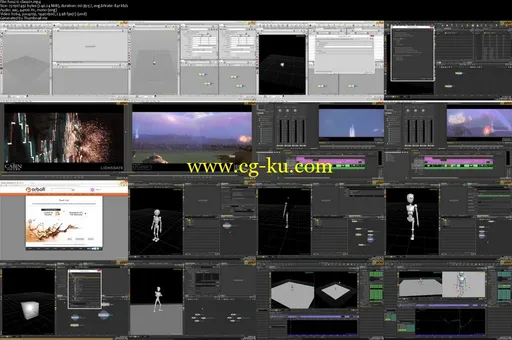
FXPHD - HOU212 Procedural Production Workflow The Force Field | 3.65GB
October 2014 | Professor: Stephen Tucker | Audio: aac, 44100 Hz, mono | Video: h264, yuv420p, 1440x900, 23.98 fps
Genre: eLearning
Houdini is a package that is renowned in the visual effects industry for it's ability to handle heavy duty effects. While it's popularity has steadily been increasing in recent years thanks to it's off-the-shelf ability to handle Pyro and Flip Fluids, it's important to keep in mind that Houdini has had a rich, multi-decade history pushing procedural, network based workflow.
In this series of classes, we will stow the shelf and work on building up a solid understanding of how Houdini works. Our goal with this series is to build up a solid foundation and put together an arsenal of skills that will allow us to tackle a wide range of effects in production. While the intention is to garner an excellent familiarity with general Houdini practices; we'll be training ourselves using one effect in particular: The Force Field.
Force fields are a popular element in a wide variety of games and film. We'll look at some of the techniques necessary to create this magical effect, using a combination of surface manipulation, recursive operations, particles, and shading. We're going to get comfortable passing data through a variety of networks to get what we want out of our effect and leave you with a better understanding of how to use Houdini to accomplish whatever you want.
The course is taught by Stephen G. Tucker, who came first from a classical animation background to Maya, to Houdini. He has worked with Side Effects Software Inc. where he managed the internship program, helped troubleshoot customer files, and create learning material. He has since worked on films in Toronto, Sydney, and Vancouver.
course syllabus
Class 1:
Project Breakdown and Getting Started: Once we get Houdini installed and configured the way we want, we're going to spend time this class investigating how force fields have been used in the past and formulate a plan for how we'll tackle one ourselves.
Class 2:
Magical Elements 1: We'll start off getting a basic start on the timing and placement of our main effect before changing over to other elements. We'll look at creating a magical aura around our character and sending out a shock wave.
Class 3:
Magical Elements 2: In our third class, we'll create a symbol of power. Since we're focusing on getting a fantasy look from our effect we'll need to control some magic particles; something that Houdini shines in.
Class 4:
Creating the Particles: We'll work at creating a layer of our effect using points and see how we can continue to add recursive attributes onto points to get the control that we need out of our geometry.
Class 5:
Creating the Surface: It's time to create the second layer of the force field the geometry. We'll look at how we can keep the particles in-line with what the surface is doing and vice versa to make sure that everything fits together coherently.
Class 6:
Interaction: What's a force field if there's nothing to collide against it? We'll look at how we can get the force field to react with other effects.
Class 7:
Dissolving The Effect: Just as important as creating an effect, is figuring out a way to kill it. We'll look at how we can disintegrate our effect.
Class 8:
Shading: In today's class we'll dive into the shading context and look at how we can make the most of our particles and surface. Procedural noise, ramps, and normals are going to become second nature here.
Class 9:
Rendering & Compositing: The last stage is finally upon us. We look at how we'll actually get our field rendered and some techniques we can use in comp to make our effect better.
Class 10:
Exploring The Effect Houdini's strength is the ability to compartmentalize work flows and easily make modifications to a project. Though our project has had a specific end result, we're going to take a moment to reflect on what we've done and see how we could have taken things in a different direction.

发布日期: 2015-01-10